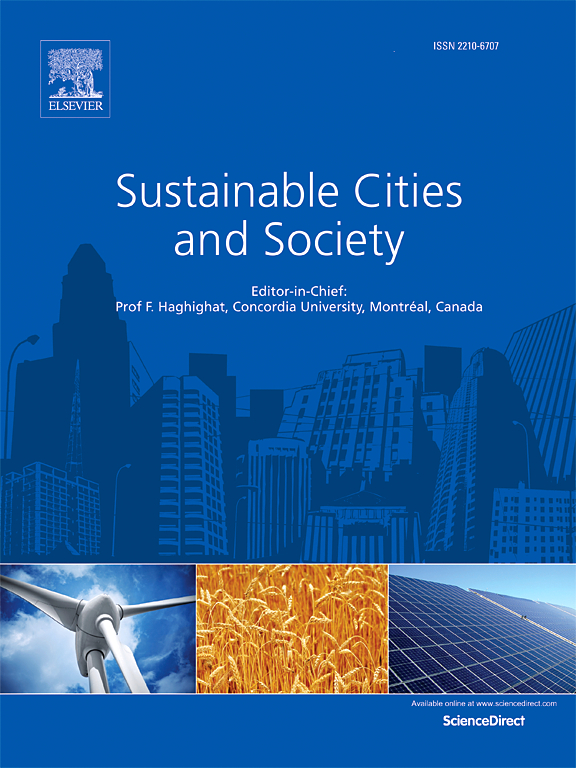IF 10.5
1区 工程技术
Q1 CONSTRUCTION & BUILDING TECHNOLOGY
引用次数: 0
摘要
全球气候变暖和快速城市化显著加剧了城市热岛效应(HI),缓解热岛效应可以促进城市可持续发展,提高居民宜居水平。相关研究主要从冷岛(CI)或热岛网络的单一视角探讨缓解热岛效应的方法,忽略了城市内部复杂的温度梯度驱动下 CI 与热岛之间潜在的冷热相互作用过程,在一定程度上限制了缓解策略的全面性。因此,建立 CI 与 HI 之间的潜在联系对于实现城市热环境的系统优化尤为重要。我们以西安市主城区为研究对象,结合形态空间模式分析(MSPA)、景观连通性、回路理论和鲁棒性分析,从多角度、多层次构建了CI通风网络(CIVN)和冷热通风网络(CHVN)。CIVN 识别并强化了城市冷系统,而 CHVN 则建立了 CI 与 HI 之间的气流交互路径。这也反映了 HI 对 CI 的影响,HI 对 CI 的影响远远大于来自 CI 气流的影响。CI 受热流影响后,CIVN 的鲁棒性会下降,而根据城市规划和 VN 的关键节点增加 CI 后,CIVN 的鲁棒性会提高。此外,优先保护低 LSI 和高节点度(低承载能力和高热流威胁)的 CI 可以防止 CIVN 退化。本研究有望为减缓城市 HI 影响提供新思路,并为制定气候适应性城市规划和促进城市可持续发展提供指导。本文章由计算机程序翻译,如有差异,请以英文原文为准。
Urban ventilation network identification to mitigate heat island effect
Global warming and rapid urbanization aggravate the urban heat island (HI) effect significantly, and alleviating the HI effect can promote urban sustainable development and improve residents' livability. Relevant studies mainly use the single perspective of cold island (CI) or HI network to discuss the methods of mitigating HI, which ignores the potential cold and hot interaction process between CI and HI driven by complex temperature gradient inside the city, limiting the comprehensiveness of mitigation strategies to a certain extent. Therefore, it is particularly critical to establish the potential connection between CI and HI to achieve systematic optimization of urban thermal environment. Taking the main urban area of Xi'an as the research object, we combined morphological spatial pattern analysis (MSPA), landscape connectivity, circuit theory and robustness analysis to construct CI ventilation network (CIVN) and cold heat ventilation network (CHVN) from multiple perspectives and levels. CIVN identifies and strengthens the urban cold system, while CHVN establishes the airflow interaction path between CI and HI. This also reflects the impact of HI on CI, which has a far greater impact on CI than the impact from CI airflow. CIVN robustness decreases after CI is impacted by heat flow, while CIVN robustness is improved by adding CI according to urban planning and key nodes of VN. In addition, priority protection for CI with low LSI and high node degrees (Low bearing capacity and high heat flow threat) can prevent CIVN degradation. This study is expected to provide new ideas for mitigating urban HI effects, and also provide guidance for making climate-resilient urban planning and promoting urban sustainable development.
求助全文
通过发布文献求助,成功后即可免费获取论文全文。
去求助
来源期刊

Sustainable Cities and Society
Social Sciences-Geography, Planning and Development
CiteScore
22.00
自引率
13.70%
发文量
810
审稿时长
27 days
期刊介绍:
Sustainable Cities and Society (SCS) is an international journal that focuses on fundamental and applied research to promote environmentally sustainable and socially resilient cities. The journal welcomes cross-cutting, multi-disciplinary research in various areas, including:
1. Smart cities and resilient environments;
2. Alternative/clean energy sources, energy distribution, distributed energy generation, and energy demand reduction/management;
3. Monitoring and improving air quality in built environment and cities (e.g., healthy built environment and air quality management);
4. Energy efficient, low/zero carbon, and green buildings/communities;
5. Climate change mitigation and adaptation in urban environments;
6. Green infrastructure and BMPs;
7. Environmental Footprint accounting and management;
8. Urban agriculture and forestry;
9. ICT, smart grid and intelligent infrastructure;
10. Urban design/planning, regulations, legislation, certification, economics, and policy;
11. Social aspects, impacts and resiliency of cities;
12. Behavior monitoring, analysis and change within urban communities;
13. Health monitoring and improvement;
14. Nexus issues related to sustainable cities and societies;
15. Smart city governance;
16. Decision Support Systems for trade-off and uncertainty analysis for improved management of cities and society;
17. Big data, machine learning, and artificial intelligence applications and case studies;
18. Critical infrastructure protection, including security, privacy, forensics, and reliability issues of cyber-physical systems.
19. Water footprint reduction and urban water distribution, harvesting, treatment, reuse and management;
20. Waste reduction and recycling;
21. Wastewater collection, treatment and recycling;
22. Smart, clean and healthy transportation systems and infrastructure;
 求助内容:
求助内容: 应助结果提醒方式:
应助结果提醒方式:


